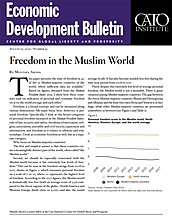1. According to the Pew Research Center there are currently 51 Muslim‐majority countries in the world. Mapping the Global Muslim Population. A Report on the Size and Distribution of the World’s Muslim Population (Washington: Pew Research Center, 2009). Eleven of them are not included in this paper due to lack of sufficient data. These are Afghanistan, Comoros, Djibouti, Kosovo, Maldives, Mayotte, the Palestinian territories, Somalia, Turkmenistan, Uzbekistan, and Western Sahara. Also, there are large Muslim minorities in India, Ethiopia, China, Russia, and elsewhere, which are not included in this paper.
2. All data in this paper are obtained from the Human Freedom Index 2019, which uses 76 distinct indicators of personal and economic freedom to rank 162 countries for which sufficient data are available. Ian Vásquez and Tanja Porčnik, Human Freedom Index 2019 (Washington: Cato Institute, Fraser Institute, and Friedrich Naumann Foundation for Freedom, 2019).
3. For a recent analysis of this freedom deficit in the Muslim world and its historical origins, see Ahmet T. Kuru, Islam, Authoritarianism, and Underdevelopment: A Global and Historical Comparison (Cambridge: Cambridge University Press, 2019).
4. The largest Muslim minorities in Western liberal democracies are in France (5.72 million); Germany (4.75 million); the United Kingdom (4.13 million); the United States (3.45 million); Italy (2.98 million); Spain (1.18 million); Canada (1.14 million); Netherlands (880,000); Belgium (879,000); Sweden (800,000); Austria (712,000); Australia (650,000); Switzerland (440,000); Denmark (313,000); Finland (150,000); Norway (142,500); Ireland (70,000); and Portugal (65,000). For these numbers and also the global Muslim population, see: “Muslim Population by Country 2020,” World Population Review.
5. James Madison, “Political Observations,” Letters and Other Writings of James Madison, vol. 4 (Philadelphia: J. B. Lippincott, 1865), pp. 491–92.
6. Daniel Philpott, Religious Freedom in Islam: The Fate of a Universal Human Right in the Muslim World Today (New York: Oxford University Press, 2019), pp. 114–49.
7. Philpott, Religious Freedom in Islam, p. 52.
8. Jamal Khashoggi, “What the Arab World Needs Most Is Free Expression,” Washington Post, October 17, 2018.
9. Salem Ben Nasser Al‐Ismaily, Miguel Cervantes, and Fred McMahon, Economic Freedom of the Arab World: 2019 Annual Report, (Vancouver: Fraser Institute, 2019), p. 2.
10. Victor A. Menaldo, “The Middle East and North Africa’s Resilient Monarchs,” Journal of Politics 74, no. 3 (July 2012): 707–22.
11. Fareed Zakaria, “The Rise of Illiberal Democracy,” Foreign Affairs 76, no. 6 (November/December, 1997).
12. Shadi Hamid, “The Future of Democracy in the Middle East: Islamist and Illiberal,” The Atlantic, May 6, 2014.
13. Hamid, “The Future of Democracy in the Middle East.”
14. For a critique of the Western policy of “cozying up to authoritarian regimes, as long as they were secular,” see Dalibor Rohac, “Understanding Political Islam,” Cato Institute Economic Development Bulletin no. 20, June 23, 2014.


